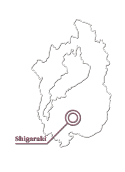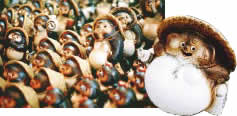Traces of Shigaraki-no-miya Palace
Shigaraki-no-miya-a designated historical landmark-formerly as the detached
palace of Emperor Shoumu and was built on a mountainous area now covered
with thickets. In Tenpyo 14 (742), Shomu built this imperial villa, while
making the wish to cast a large image of the Buddha in this area. After
several ceremonial events, he decreed this residence the Imperial Palace.
However, two years later, in Tenpyo 16, the capital moved to Nara, and as
a result, the Great Buddha was consecrated at Todai-ji Temple in Nara.
Today, only a few foundation stones of this former
palace remain. As the historical beginnings of Shigaraki, this land evokes
the imagination of an era now long gone.
|
Remains of Shigaraki-no-miya Palace
Located in Kinose, Shigaraki-cho. Take the
Shigaraki Kogen Railway to Shigaraki-no-miya Ato Station. From there,
it is a ten-minutes walk.
|
|
 |
Hando Shrine
This ancient shrin is situated near the top of Mount Hando, which sits between
the towns of Minakuchi and Kosei. Built in the Nara Period, hando Shrin
prospered as a sacred place for mountain ascetics. Later, this shrin was
destroyed in a mountain fire. The main shrine building, which was rebuilt
in the early Edo period, is reminiscent of the ornate style of the Momoyama
Period and has been designated as an Important Cultural Property in Japan.
A thirty-minute walk from the foot to the shrine,
this area-once known as the training grounds for the Koga-style ninjas-can
be reached through a somewhat steep mountain path. The unforgettable view
from near the mountaintop displays nature at its best.
|
Hando shrine
Located in Miya-machi, Shigaraki. It takes
approximately eighty minutes from Shigaraki-no-miya Ato Station
on the Shigaraki Kogen Railway to the shrine.
|
|
 |
Keimei Fall
The ruins of an old temple can be found atop Sasagaoka Hill near the border
of Mie Prefecture. According to legend, a golden rooster that proclaimed
happiness on the morning of the New Year lived by Aka Ike, a pond on the
temple precincts. The name, Keimei no Taki, the Fall of the “Rooster’s
Cry”, comes from this story.
Keimei Fall is located approximately ten minutes
from the center of town. As you climb up the quiet forested path, you can
hear its roaring sound and see its iridescent mist. Your heart and mind
will be refreshed by the cool feeling and beauty of this fall.
|
Keimei Fall
At Koyama in Shigaraki-cho
A fifteen-minutes taxi ride from Shigaraki Station on the Shigaraki
Kogen Railway.
|
|
 |
The Shigaraki Ceramic Park
At the Shigaraki Ceramic Cultural Park-on a hill overlooking the town of
Shigaraki-one can find resources on Shigaraki ware. The Exhibition Hall
of Industrial Ceramics introduces and displays Shigaraki ceramics. The Institute
of Ceramic Studies is a center, where potters can train and study traditional
and contemporary ceramics. Art offers various ceramic exhibitions.
This year marks the 10th anniversary of this facility,
which serves as a place for international exchange and as a cultural park
bringing together together people, ceramics, and information. One can enjoy
the natural beauty of the nearby forest by visiting the outdoor exhibition
space and by strolling through their walking course.
|
The Shigaraki Ceramic Cultural
Park
Located in Chokushi, Shigaraki-cho.
For more information, contact them at 0748-83-0909.
|
|

 |
The Traditional Craft Center of Shigaraki
This center introduces the history and contemporary movements in Shigaraki
ware. You can see pieces from as early as the Tenpyo period as well as innovative
works by contemporary artists. You can visually trace the steps of this
traditional ware here.
|
The Traditional Craft Center of
Shigaraki
Located in Nagano, Shigaraki-cho.
For more information, contact them at 0748-82-2345.
|
|
 |










